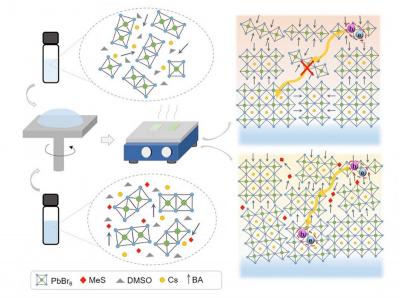A joint research project by scientists from several China-based universities and laboratories has developed a 2D perovskite material for highly efficient LEDs.
 Effects of MeS on phase distribution of perovskite films. The yellow path indicates the exciton energy transfer between nanosheets of different thicknesses. Credit: Nature
Effects of MeS on phase distribution of perovskite films. The yellow path indicates the exciton energy transfer between nanosheets of different thicknesses. Credit: Nature
LEDs are ubiquitous, but current high-quality LEDs still need to be processed at high temperatures and require elaborate deposition technologies ' which makes their production cost expensive. Scientists have recently realized that metal halide perovskites can be extremely promising candidates for next generation LEDs. These perovskites can be processed into LEDs from solution at room temperature, thus largely reducing their production cost. However, the electro-luminescence performance of perovskites in LEDs still has room for improvements.
They worked with two-dimensional (2D) perovskites (also known as Ruddlesden Popper perovskites) and succeeded to achieve efficient and bright LEDs, with best reported performance on both current efficiency and external quantum efficiency for devices based on this kind of perovskites.
The key to the powerful change lies in the addition of around 10% of a simple organic molecule called methanesulfonate (MeS).
In this study, the 2D perovskites used by the team have a nanometer level thickness. The MeS reconstructs the structure of the 2D perovskite nanosheets, while at the same time enhancing exciton energy transfer between sheets of different thicknesses. Both of these changes have greatly enhanced the electro-luminescence of the thicker, green-emitting perovskite sheets within the 2D structure.
The MeS is also useful in reducing the number of defects in the 2D perovskite structure. During the process of light production, where radiative recombination took place, part of the excitons that are required for the process will be 'wasted' in the non-radiative recombination which produces no light. MeS reduces the number of uncoordinated Pb2+ cations, the cause for excitons to undergo the non-radiative recombination, making sure more excitons participating in light production.
The results of the research for producing better LEDs seem very encouraging. Brightness of 13,400 candela/m2 at a low applied voltage of 5.5 V, and external quantum efficiency of 20.5% are recorded. This is close to the maximum that can be achieved by many existing LED technologies, and has almost doubled the external quantum efficiency level of 10.5% reported in their previous study two years ago.
'My CityU team has built-up its expertise on perovskite materials to a very high level in a relatively short period of time, thanks to funding support from Senior Research Fellowship by the Croucher Foundation. And already we are seeing the benefit, especially in the outcomes detailed in this latest publication,' said Professor Rogach.
'The high brightness, excellent color purity, and commercial grade operating efficiency that has been achieved marks 2D perovskites as an extremely attractive materials for future commercial LEDs, and potentially also display technology. It's a tangible outcome from both fundamental and applied research into novel nano-scale materials' he adds.